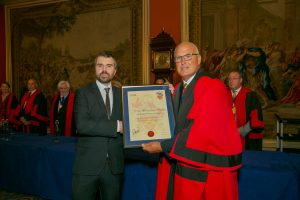SIR IAN DIXON SCHOLARSHIP
ABOUT THE SCHOLARSHIP
Sir Ian Dixon was CIOB’s President from 1989 to 1990 and head of Willmott Dixon. He was an enthusiastic supporter of innovation and education within the industry. The scholarship was established in 1997. It is funded and supported by the Sir Ian Dixon Legacy, The Chartered Institute of Building and The Worshipful Company of Constructors Charitable Trust.
The successful scholar will continue to work during the 2 year programme, carrying out a research project which will benefit the scholar, their company and the industry. The specific subject of the research will be proposed by the applicant, addressing topical challenges and opportunities facing our industry. This could relate to any discipline or area of construction including legal, technical or management practices. It could be a new project or extend existing work of the scholar or employer to increase its value to a wider audience in industry.
CURRENT SCHOLARS
I started my career in construction working for a Construction Recruitment agency in Southampton. I loved my job but I always wanted to do a little more. By chance I was introduced to working with prisons. That was 6 years ago and I have never looked back. I joined O’Neill & Brennan in London, to set up a Social Value strategy and make a difference to the communities in which we work. In the past 18 months we have employed over 100 people from prison across a variety of routes.
That brings me nicely onto my study topic. Something that never sat right with me was the difference in educational offerings between female and male prison estates. There is a vast amount of construction skills offed in the male estate but current no construction related training in the female estates.
I am working closely with the female estate to discover the barriers to work which they face, offer training, mentors and work placements. I will be exploring the outcomes, with the intent of encouraging the construction industry to develop academies within the female estates.
I graduated from the University of Birmingham with a masters degree in Geology in 2012 and for the past 10 years have been working with The LK Group, a ground investigation specialist based in Manchester and London. What began as investigation work mainly from a contaminated land and human health perspective has grown over the years to also deal with ground conditions for foundations and slope stability purposes, allowing me to make more use of my skills. In 2021 I began a part time degree at the University of Leeds while working at LK, and I have now achieved a masters in Geotechnical Engineering. I am continuing to research into the use of non-intrusive methods for slope stability assessment.
Project Abstract
Whether Victorian railway embankments or Motte and Bailey castles there is a long history of earthworks in the UK. Many of these geostructures were constructed long before any standards, code of practice or even suitable compaction equipment were available. As climatic patterns become more erratic, with increased rainfall, flooding and extensive drought, it is important to understand how these changes may effect the stability of such geostructures, from the onset of cracking, water ingress, local slope failure and washouts. This study aims to develop a non-invasive approach to evaluate the current and future performance of these geostructures, helping to identify future instabilities that can then be rectified before they lead to failure, and assess the importance of vegetation in preventing slope failure.
I am a structural engineer at keltbray group, with several years in the construction industry and the last two years helping Keltbray structures with the delivery of commercial buildings. Specializing in post-tensioned concrete, I use this experience to bring new constructions solutions to the innovations department.
By focusing on value engineering, I have been able to put the master earned at Universitat Politecnica de Catalunya to good use. Over the years, his strengths at structural design has garnered some recognition by past employers, both consultancies and contractors. I may spend my days at Keltbray sites, but it is the pursuit of new construction solutions that gets me up in the morning.
When I am not at Keltbray, I am an avid traveller and loves spending time playing football.
Project Summary
Fibre-Slab is a response to the UK committed target to zero carbon emissions by 2050. The energy and raw materials crisis due to political and economic instability has also inspired the research, which focus on the rationalisation of construction materials.
Most PT slabs in the UK residential buildings use minimum reinforcement bars to satisfy industrial practices, increasing the overall cost, carbon emissions, clashes with tendons or other cast-in items, etc.
The principle of fibre-slab is the replacement of reinforcement bars with synthetic fibres. The carbon footprint of concrete reinforced with macro synthetic fibres is significantly lower than that of steel reinforced concrete. The research looks for a potential reduction of carbon emissions up to 60% compared to traditional RC or PT slabs.
In addition to the reduction of emissions, the replacement of reinforcement bars would bring other equally important benefits. Because the fibres are mixed with the concrete before delivered to site, that also helps the reduction of labour, health & safety, logistics and site programme.
Having obtained a master’s degree in Structural Engineering Claire is now a Chief Engineer for Sir Robert McAlpine and responsible for delivery of the external works on the Battersea phase 3A development. Her experience and responsibility have grown over the last decade, working on several multi-million projects, and spent some of her early career working in Australia. Claire was the Winner of NAWIC- National Association of Women in Construction Award 2012, award title: “Outstanding Contribution to Women in Construction” and works to promote STEM (Science, Technology, Engineering and Math’s) subjects within schools. She is also a volunteer for Age UK.
PAST SCHOLARS
Having completed a foundation year in engineering Jamie then completed several work experience jobs in the UK and abroad and also short contract onsite roles. His current role as an Apprentice Building Services Engineer at Sir Robert McAlpine, based at a £500m Victoria Park (residential tower, hotel, and car park) development in Manchester. His responsibilities include managing the installation of site wide gullies which has a value of £5 million and the M&E side of site wide external hard landscaping which has a value of £100 million. Jamie is currently studying for a 4-year Batchelor of Engineering, 1 day per week at London South Bank University and this scholarship project could contribute to this qualification.
Jamie’s Sir Ian Dixon Scholarship Presentation Evening
Jamie’s Constructor’s Couch Interview
 “Creating value through contractor design in large scale infrastructure projects”
“Creating value through contractor design in large scale infrastructure projects”
“How can temporary towns and architecture provide a place of architectural quality whilst temporarily being on a site?”
“The UK’s Forgotten Youth”
“Additive Manufacture: Structural Freedom and Architectural Complexity”
“Increasing Primary School Places in London and the South ”
“Construction as a career choice for Young People”


